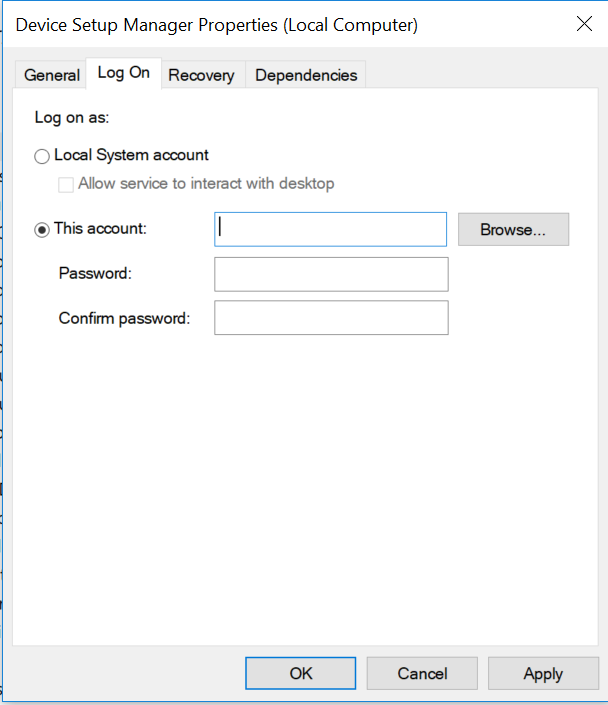Pozi Connect Installation
Pre-Installation tasks
Server provisioning (by site IT rep)
- We recommend provisioning a new virtual server with Windows Server 2019.
- Pozi Connect installs as a Windows Service and has no dependencies. (No IIS required)
- The installed Windows service binds to port 443 (HTTPS).
- The server must have access to *.pozi.com
Windows Service Account (by site IT rep)
** Skip this section if only require to run the windows service as a local account - this would likely require clarification by the site IT administrator, but it would be more usual to run the Windows Service as a domain user account (not a local user account), so this section should NOT be skipped **
The Pozi Connect Windows Service runs by default as a local system account. If Pozi needs access to network resources and/or databases (eg. VRT files which reference network resources), the Pozi Connect Windows service may need to be configured to run as a domain user. That domain user should be provisioned as follows:

Local DNS configuration (by site IT)
** Skip this section if you do not have a local DNS server **
- For sites with a local DNS server, a DNS entry should be created.
- Add "local.pozi.com" as a "forward lookup zone (primary)" then create an "A record with no hostname" (matches zone) to the internal server, also see screenshot. For more detailed instructions search Google for "add dns entry for domains outside your local domain".

To confirm the DNS configured correctly, open a command prompt window and ping local.pozi.com. It should return a reply from the same server IP on which Pozi Connect Server is/will be installed.
Local HOSTS file setup (by site IT)
** Skip this section if you setup a local DNS **
- If there is no local DNS server then hosts records must be created on each client PC.
- NOTE: The install process automatically adds a hosts file entry to the local PC.
- Edit c:\windows\system32\drivers\etc\hosts as administratorand add [SERVERIP] local.pozi.com
Shared application server checks (Pozi people)
** This section can be skipped if this is new virtual server. **
- While we have instances of Pozi Connect running on shared servers we do not recommend it, however if that is the only option, then perform these checks.
- Check the shared server has nothing running on https (port 443). Sometimes the default install of IIS has had a binding added for port 443. You can check this by launching https://localhost/ To remove the default IIS binding you can load the IIS config manager and remove the HTTPS binding from the default website and restart IIS.
- If and only if HTTPS is in use by another application on the same server can set a system environment variable POZI_CONNECT_PORT to point to a different port number. E.g. 3001. (If you already installed PoziConnectServer, then restart the service and access the webserver as appropriate, e.g. https://local.pozi.com:3002/)

Control Panel > System and Security > System > Advanced system settings > Environment Variables > System variables
- Check if Pozi Connect M1 is already installed (usually in C:\PoziConnect) (Also there is likely an Icon on the desktop). If there is an icon on the desktop, temporarily rename it to something else, eg PoziConnect_OLD, so that it doesn't get overridden by PoziServer installation process. This will need further migration steps by SOK (see M1 migration section below).
- On the server we recommend installing Google Chrome with the provided user credentials. This serves two purposes: 1) Confirms the user you are logged in as has permissions to install stuff on the server and 2) Will make the rest of this install guide much easier than using IE.
Installation
Remote access
If you wish to have Pozi support perform the install on your behalf, please provide a user account with administrator privileges to the server and remote access details. E.g. Citrix/VPN/etc details. (The user account should not be the same as the Windows Service account.)
- For sites with a local DNS (ping local.pozi.com, if the return is from cloudfront that means no DNS configured), consider removing the hosts file entry for local.pozi.com in order to test that the local DNS is working.
Windows service account configuration

- select "Log on as: This account"
Pozi Connect Server Directory Permissions
Migration
** Skip this section if this was a fresh install **
- Existing PoziServer installs need the VRT files copied to the new install location. Copy C:\PoziServer\application\data\vrt folder to C:\Program Files (x86)\Pozi\userdata\local\vrt
- Update Pozi Web Map config manager dataset endpoints with the new URL. E.g. Update this type of endpoint http://192.168.0.234:3000/ogr2ogr... to https://local.pozi.com/ogr2ogr...
Public Data Publishing Module
Pozi staff refer to https://trello.com/c/GmoNIF78/160-poziconnect-data-sync-customer-onboard-process
Contact us for a quote and to provision credentials to publish your datasets to the Pozi Public Cloud
- Load https://local.pozi.com/settingssync in a browser.
- Enter credentials provided by Pozi support.
- Restart PoziConnectServer windows service.
- Test this by copying a file to C:\Program Files (x86)\Pozi\userdata\public to make it available at https://connect.pozi.com/userdata/[SITENAME]/public/*
- Pozi Web map can be used to display these endpoints to your customers. Ask us how!
Testing Data Connections
runas /user:(full user account name, including domain) cmd
M1 Migration
M1 and Audit files
Data file
Troubleshooting
Application testing is performed against Windows Server 2019 but we have working sites from Windows Server 2008.
Note that the packaged GDAL library does not support 64 ODBC DSN connections.